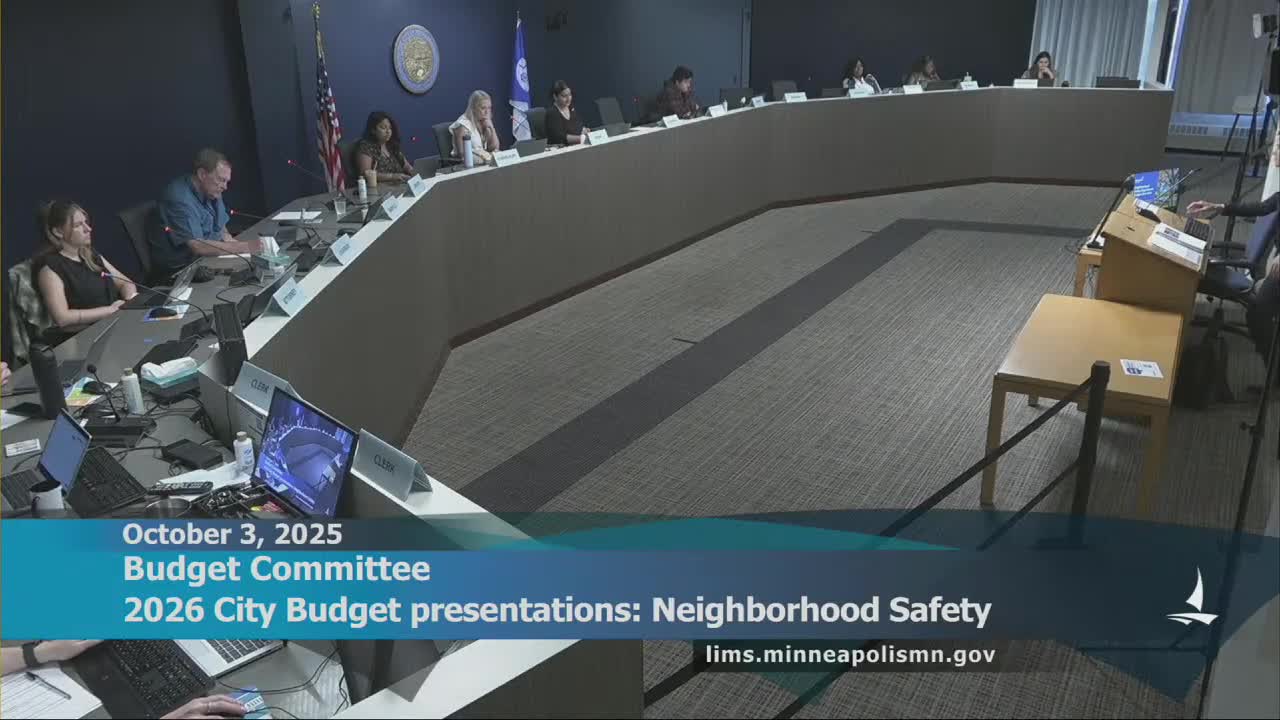Neighborhood Safety director details staffing, data push and looming grant cliff
October 04, 2025 | Minneapolis City, Hennepin County, Minnesota
This article was created by AI summarizing key points discussed. AI makes mistakes, so for full details and context, please refer to the video of the full meeting. Please report any errors so we can fix them. Report an error »

Amanda Harrington, director of the Neighborhood Safety Department (NSD), presented the department's 2026 budget overview and program updates to the Budget Committee on Oct. 3.
“The mission of Neighborhood Safety is to apply [a] public health approach to violence prevention,” Harrington told the committee, summarizing NSD’s focus on prevention, restoration and capacity building and outlining objectives for better data collection, dashboards and contract compliance.
Nut graf: Harrington said NSD has rebuilt capacity this year — authorizing 17 FTEs, adding seven new staff across programming, contract administration and data — and strengthened contract oversight through new invoice trainings, revised RFP evaluation and documentation requirements. At the same time she warned of a fiscal cliff: a federal Byrne grant that funded violence interrupter work — reported by staff as $2,500,000 — ends this year, and the department depends heavily on general fund and one‑time dollars for pilots such as the safety ambassador program.
Harrington outlined program metrics year-to-date through September 2025: the Minneapolis Strategic Outreach Initiative reported 271 mediations by outreach teams; group violence intervention programs reported no adult clients engaging in violent activity since program enrollment and 19 youth engaged in the youth GVI program; a sample workforce program (Hired’s Journey Forward) reported 30 group-involved youth served in 2025 with 18 resumes created and 33% employment among participants. NSD’s hospital-based intervention contractor, Next Step, recorded 186 participants (as reported in the presentation), and the community trauma response contracts have reported 8,242 engaged individuals year‑to‑date.
Harrington said NSD is developing public dashboards — including a violence-interrupter historical data set, outreach team coverage maps and an ambassador dashboard expected by year-end — and aims to migrate all NSD contracts into accessible dashboards over time. She estimated about 60 active contracts under NSD oversight at the time of the presentation and described five major RFPs issued this year.
On funding, Associate Director of Finance Lindsay Erdman confirmed the Byrne grant began 7/1/2024 and expires 12/31/2025. Harrington said the safety ambassador pilot is funded with $3,000,000 in public safety aid; that money is not yet expended and may cover more than a single year depending on scope and site size, but there is no ongoing revenue identified to continue the pilot beyond one-time funds.
Committee members pressed on contract transitions from CPED, the department's reliance on earmarked funds for specific neighborhoods (Whittier, Hiawatha, Longfellow), and efforts to attract philanthropic support. Harrington said transition planning with CPED is needed to fully understand contracts and budget implications, and reported ongoing outreach to philanthropic partners.
The committee had no formal vote on the presentation; the clerk filed the presentation for the record.
“The mission of Neighborhood Safety is to apply [a] public health approach to violence prevention,” Harrington told the committee, summarizing NSD’s focus on prevention, restoration and capacity building and outlining objectives for better data collection, dashboards and contract compliance.
Nut graf: Harrington said NSD has rebuilt capacity this year — authorizing 17 FTEs, adding seven new staff across programming, contract administration and data — and strengthened contract oversight through new invoice trainings, revised RFP evaluation and documentation requirements. At the same time she warned of a fiscal cliff: a federal Byrne grant that funded violence interrupter work — reported by staff as $2,500,000 — ends this year, and the department depends heavily on general fund and one‑time dollars for pilots such as the safety ambassador program.
Harrington outlined program metrics year-to-date through September 2025: the Minneapolis Strategic Outreach Initiative reported 271 mediations by outreach teams; group violence intervention programs reported no adult clients engaging in violent activity since program enrollment and 19 youth engaged in the youth GVI program; a sample workforce program (Hired’s Journey Forward) reported 30 group-involved youth served in 2025 with 18 resumes created and 33% employment among participants. NSD’s hospital-based intervention contractor, Next Step, recorded 186 participants (as reported in the presentation), and the community trauma response contracts have reported 8,242 engaged individuals year‑to‑date.
Harrington said NSD is developing public dashboards — including a violence-interrupter historical data set, outreach team coverage maps and an ambassador dashboard expected by year-end — and aims to migrate all NSD contracts into accessible dashboards over time. She estimated about 60 active contracts under NSD oversight at the time of the presentation and described five major RFPs issued this year.
On funding, Associate Director of Finance Lindsay Erdman confirmed the Byrne grant began 7/1/2024 and expires 12/31/2025. Harrington said the safety ambassador pilot is funded with $3,000,000 in public safety aid; that money is not yet expended and may cover more than a single year depending on scope and site size, but there is no ongoing revenue identified to continue the pilot beyond one-time funds.
Committee members pressed on contract transitions from CPED, the department's reliance on earmarked funds for specific neighborhoods (Whittier, Hiawatha, Longfellow), and efforts to attract philanthropic support. Harrington said transition planning with CPED is needed to fully understand contracts and budget implications, and reported ongoing outreach to philanthropic partners.
The committee had no formal vote on the presentation; the clerk filed the presentation for the record.
View full meeting
This article is based on a recent meeting—watch the full video and explore the complete transcript for deeper insights into the discussion.
View full meeting
